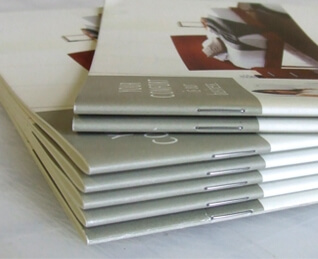 Saddle stitching refers to a binding process where pages are stapled together through the spine of the book. The machine (which looks a bit like a horse saddle) cuts the wire, forms the staple, drives it through the paper and clinches it from the other side.
Saddle stitching refers to a binding process where pages are stapled together through the spine of the book. The machine (which looks a bit like a horse saddle) cuts the wire, forms the staple, drives it through the paper and clinches it from the other side.
The section is stitched a little over half a centimetre from the edge in two or more places, depending on the length of the publication. The stitched section then becomes the spine of the booklet, over which a cover may then be glued. This form of binding is typically used for brochures, small booklets, calendars, pocket-size address books and some magazines.
Saddle stitching is fast and more economical than many other methods. The advantages include reliability, cost effectiveness, and the ability to gain closer access to the gutter of the binding margin.
The staples used in saddle stitching are usually formed from round wire and are generally made of copper, galvanised iron or aluminised iron. The number of pages that can be stitched depends on how thick the paper is. When the document is too large for saddle stitching, it may be side-stitched or side-stapled.
See the print and design experts at Kwik Kopy Printing for saddle stitching, binding and finishing touches of all sorts.
For more handy design and printing tips, head to your nearest Kwik Kopy Centre.






